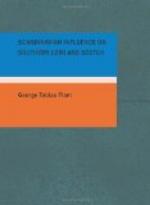in Cumberland and Westmoreland that the proportions
are nearly the same, but on by see below Sec.5.
Tveit is far more common in Norway than tved
in Denmark. The form of the word in place-names
in England is, furthermore, more Norse than Danish.
In the earliest Scandinavian settlements in England,
those of Lincolnshire, for instance, thwaite
might be Danish if it occurred, for monophthongation
of aei to e did not take place in Danish
before about the end of the 9th Century; by about 900
this was complete (see Sec.6). The Scandinavian
settlements in Northwestern England, however, did
not take place so early, consequently if these names
were Danish and not Norse we should expect to find
thwet, or thweet (tweet), in
place of thwaite. It is then to be regarded
as Norse and not Danish. Thwaite occurs almost
exclusively in Northwestern England—43
times in Cumberland as against 3 in the rest of England
south of Yorkshire. Garth (O.N. garethr,
O. Dan. gardh, later gaard), occurs
very often in Cumberland. With, ness,
holm, land, and how, do not occur
very often. How reminds one of the Jutish hoew
in Modern Danish dialect. The rest of these may
be either Danish or Norse. In Yorkshire we find
a mixed condition of affairs. East Riding, as
we should expect, has predominantly Danish names.
Thorpe, which occurs 63 times in Lincolnshire,
is found 48 times in East Riding. Fell, tarn
and haugh do not occur. Force is found
twice, and thwaite once. Dale, however,
occurs 12 times. West Riding was probably settled
by Danes from the East and by Norsemen from the West.
Thorpe occurs 29 times, with 8, toft
2, beck 4, fell 15, thwaite 6,
dale 12, and tarn 2. In North Riding
thorpe occurs 18 times. Force, fell,
and tarn together 12. The large number
of names in dale in North Riding is rather
striking (40 in all), as compared with 52 for Westmoreland
and Cumberland. While dale is predominantly
Norse, it may perfectly well be Danish, and it is not
rare in Denmark. Furthermore, the greater number
of dales in Norway as compared with Denmark
is largely accounted for by the nature of the country.
No conclusions can be drawn from names in force
in Yorkshire, Cumberland and Westmoreland, as it is
of too infrequent occurrence. Fell occurs 22
times in York, as against 57 in Cumberland and Westmoreland
(42 in Westmoreland alone), but in York occurs predominantly
in West Riding, where everything points to a mixed
settlement. The distribution of tarn is
interesting. Tarn is as distinctively Norse
as thorpe is Danish. It occurs 24 times
in Cumberland and Westmoreland, 3 in North Riding,
and is not found at all south of Westmoreland and
York.




